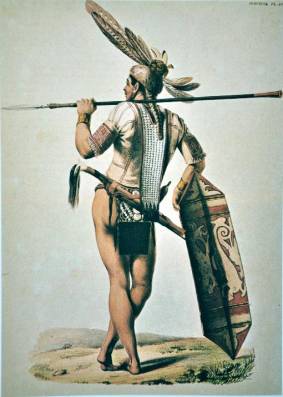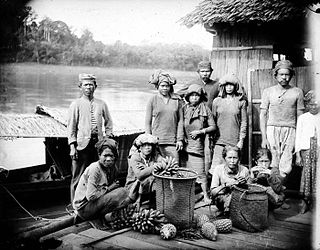Related Research Articles

South Kalimantan is a province of Indonesia. It is the second most populous province on the island of Kalimantan, the Indonesian territory of the island of Borneo after West Kalimantan. The provincial capital was Banjarmasin until 15 February 2022 when it was legally moved 35 kms southeast to Banjarbaru. The population of South Kalimantan was recorded at just over 3.625 million people at the 2010 Census, and at 4.07 million at the 2020 Census. The official estimate as at mid 2023 was 4,221,929. One of the five Indonesian provinces in Kalimantan, it is bordered by the Makassar Strait in the east, Central Kalimantan in the west and north, the Java Sea in the south, and East Kalimantan in the northeast. The province also includes the island of Pulau Laut, located off the eastern coast of Kalimantan, as well as other smaller offshore islands. The province is divided into 11 regencies and 2 cities. South Kalimantan is the traditional homeland of the Banjar people, although some parts of East Kalimantan and Central Kalimantan are also included in this criterion. Nevertheless, South Kalimantan, especially the former capital city Banjarmasin has always been the cultural capital of Banjarese culture. Many Banjarese have migrated to other parts of Indonesia, as well as neighbouring countries such as Singapore and Malaysia. In addition, other ethnic groups also inhabit the province, such as several groups of the Dayaks, who mostly live in the interior part of the province, as well as the Javanese, who mostly migrated from Java due to the Transmigration program which dated from the Dutch colonial era. It is one of the provinces in Indonesia that has a larger population than Mongolia.

Banjarmasin is the largest city in South Kalimantan, Indonesia. It was the capital of the province until 15 February 2022. The city is located on a delta island near the junction of the Barito and Martapura rivers. Historically the centre of the Banjarese culture, and the capital of the Sultanate of Banjar, it is the biggest city in South Kalimantan and one of the main cities of Kalimantan. The city covers an area of 98.46 km2 (38.02 sq mi) and had a population of 625,481 as of the 2010 Census and 657,663 as of the 2020 Census; the official estimate as of mid 2023 was 675,915. It is the third most populous city on the island of Borneo.
Negara Daha was a Hindu kingdom successor of Negara Dipa that appears in the Hikayat Banjar. It was located in what is now the Regency of Hulu Sungai Selatan, Province of South Kalimantan, Republic of Indonesia.

The Banjar or Banjarese are an Austronesian ethnic group native to the Banjar regions in the southeastern Kalimantan regions of Indonesia. Nowadays, Banjarese diaspora can be found in neighbouring Banjar regions as well; including Kotabaru Regency, the southeastern regions of Central Kalimantan, southernmost regions of East Kalimantan, and some provinces of Indonesia in general. The Banjarese diaspora community also can be found in neighbouring countries of Indonesia, such as Brunei, Malaysia, and Singapore.

The Banjar or Banjarese is an Austronesian language predominantly spoken by the Banjarese—an indigenous ethnic group native to Banjar regions— in the southeastern Kalimantan of Indonesia. The Banjarese language is the de facto lingua franca for various indigenous community especially in South Kalimantan, as well as Central Kalimantan and East Kalimantan in general.

Barito Kuala Regency is one of the regencies (kabupaten) in the Indonesian province of South Kalimantan. It is situated in the southwest of the province, bordering Central Kalimantan province to its immediate west and separated from Banjarmasin city to its east by the lower reaches of the Barito River. The regency's land area is 2,996.46 km2, and the population was 276,147 at the 2010 Census and 313,021 at the 2020 Census; the official estimate was 324,502. The capital is the town of Marabahan. The Motto of the Regency is "Selidah".
The West Barito languages are a group of half a dozen Dayak (Austronesian) languages of Borneo, Indonesia. They are named after the Barito River.
Bakumpai is an Austronesian language belonging to the West Barito languages. It is spoken by about 100,000 Bakumpai people living in the central Kalimantan, Indonesia.

Ma'anyan, Dayak Maanyan or Eastern Barito Dayak people are an ethnic group of the Dayak people indigenous to Borneo. They are also considered as part of the east Barito Dusun group with the name Dusun Ma'anyan. According to J. Mallinckrodt (1927), the Dusun people group is part of the Ot Danum people cluster, although later that theory was disproved by A. B. Hudson (1967), who argues that the Ma'anyan people are a branch of the Barito family. The Ma'anyan people who are often referred to as Dayak people are also referred to as Dayak Ma'anyan. The Dayak Ma'anyan people inhabit the east side of Central Kalimantan, especially in the East Barito Regency and parts of South Barito Regency which are grouped as Ma'anyan I. The Dayak Ma'anyan people also inhabit the northern parts of South Kalimantan, especially in Tabalong Regency which refers to the Dayak Warukin people. The Dayak Balangan people or Dusun Balangan people which are found in the Balangan Regency and the Dayak Samihim people that are found in the Kotabaru Regency are grouped together with the Dayak Ma'anyan people group. The Dayak Ma'anyan people in South Kalimantan are grouped as Ma'anyan II.

The Ngaju people are an indigenous ethnic group of Borneo from the Dayak group. In a census from 2000, when they were first listed as a separate ethnic group, they made up 18.02% of the population of Central Kalimantan province. In an earlier census from 1930, the Ngaju people were included in the Dayak people count. They speak the Ngaju language.
Lawangan is an Austronesian language of the East Barito group. It is spoken by about 100,000 Lawangan people living in the central Kalimantan, Indonesia. Lawangan has a high degree of dialectal diversity.

Bakumpai or Baraki are indigenous people of Borneo and are considered as a sub-ethnic group of the Dayak Ngaju people group with Islamic background. The Bakumpai people first occupy along the Barito riverbanks in South Kalimantan and Central Kalimantan, from Marabahan to Puruk Cahu, Murung Raya Regency. The Bakumpai people first appeared as a newly recognized people group in census 2000 and were made up of 7.51% of Central Kalimantan population, which before this the Bakumpai people were considered as part of the Dayak people in a 1930 census.
Kendayan, or Salako (Selako), is a Malayic Dayak language of Borneo. The exact number of speakers remains unknown, but is estimated to be around 350,000.

Jukung tambangan is a traditional boat made by the Banjar people of South Kalimantan. They are mainly used for riverine transportation. It is already present at least since mid-18th century. They were not seen anymore in Banjarmasin ca. 1950s and around the 1970s on the Nagara River, Hulu Sungai Selatan Regency.

The Kalimantan Physical Revolution was an armed conflict between Indonesian nationalists and pro-Dutch forces in Dutch Borneo in the second half of the 1940s. It began with the end of the Japanese occupation of the Dutch East Indies and the 1945 Proclamation of Indonesian Independence by Sukarno and lasted until the Dutch withdrew from most of Indonesia in 1949. It can be considered part of the larger Indonesian National Revolution.
Anang Ardiansyah was an Indonesian artist and songwriter, specifically in the Banjarese language. He was known to write around 103 Banjarese folk songs and was known popularly as Maestro of Banjarese music. His most famous works, "Paris Barantai," among other songs, are recognized as native folk songs of Banjarese culture and were played during the 2018 Asian Games opening ceremony in Gelora Bung Karno Stadium.

Hasanuddin Murad was an Indonesian politician affiliated with the Golkar Party. He had served in the legislature as a member of the People's Representative Council (DPR) from 1999 until 2007 and the South Kalimantan Regional People's Representative Council (DPRD) from 2019 until his death in 2023. Murad also served as the regent in his birthplace, Barito Kuala, from 2007 until 2017.

Sei Alalak Bridge is a curved cable-stayed bridge in South Kalimantan province of Indonesia. The bridge, which has length of 850 meters, crossing the Alalak river in Alalak District, Barito Kuala Regency, and connecting the regency through the main Trans-Kalimantan Road towards Banjarmasin city.

Alalak River is a tributary of the Barito River which flows in South Kalimantan, precisely at the Barito estuary between Banjarmasin City and Barito Kuala Regency. This river flows in North Banjarmasin and Alalak districts. It has a length of 10,707.939 meters with a width of 100 meters.
References
- 1 2 3 4 5 "Nyaris punah, bahasa-bahasa daerah di Kalsel direkam". merdeka.com (in Indonesian). Banjarbaru, Indonesia: Merdeka. 2013. Retrieved 2025-01-07.
- 1 2 "Dua Bahasa di Kalsel Punah". radarbanjarmasin.co.id (in Indonesian). Banjarmasin, Indonesia: Radar Banjarmasin. Retrieved 2025-01-07.[ dead link ]
- ↑ "Bahasa Berangas | Provinsi Kalimantan Selatan". petabahasa.kemdikbud.go.id (in Indonesian). Jakarta, Indonesia: Kementerian Pendidikan dan Kebudayaan. Retrieved 2025-01-07.
- 1 2 3 Hapip, Abdul D. (1984). Struktur Bahasa Barangas (in Indonesian). Jakarta, Indonesia: Pusat Pembinaan dan Pengembangan Bahasa, Departemen Pendidikan dan Kebudayaan.
- ↑ "Ritual Ratip Bejalan Dalam Masyarakat Berangas". helmibarabai.com (in Indonesian). Barabai, Indonesia: Helmi Barabai. 2009-01-08. Retrieved 2025-01-07.